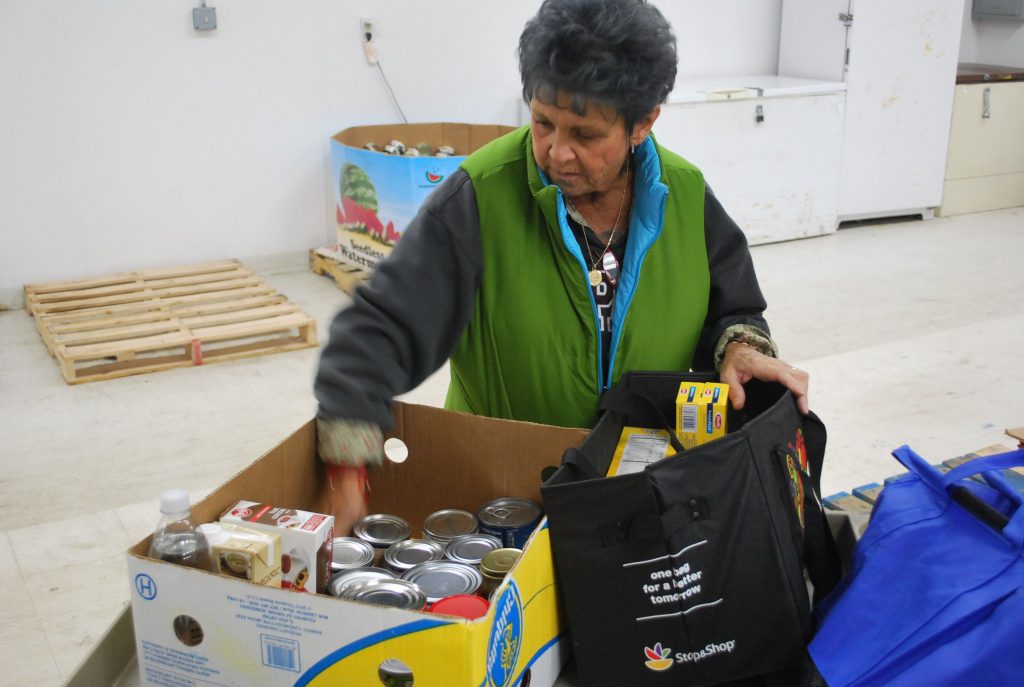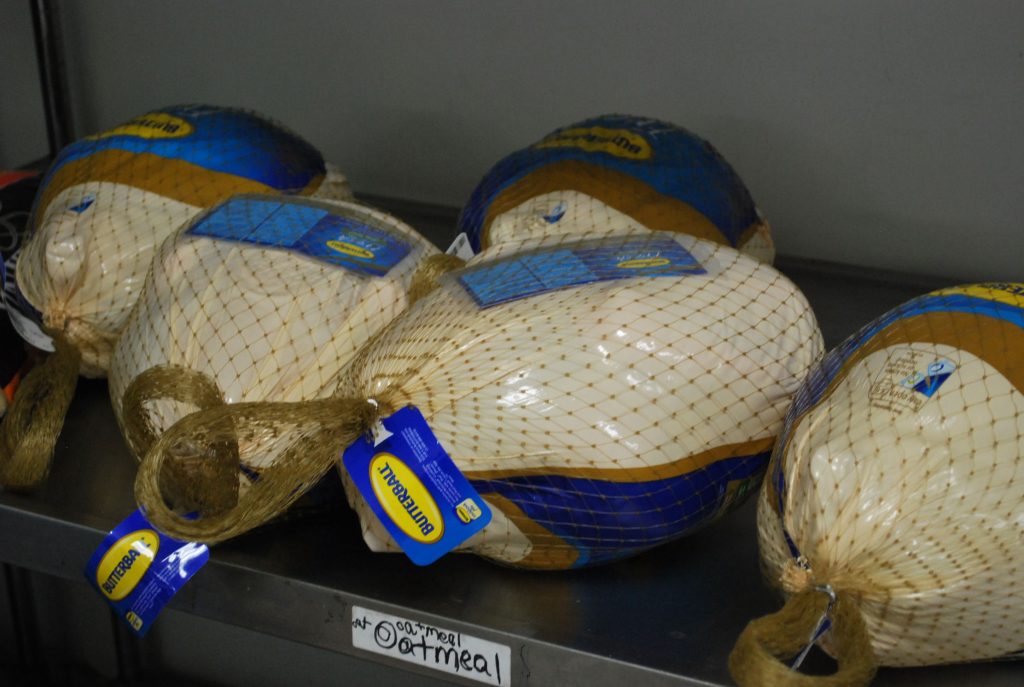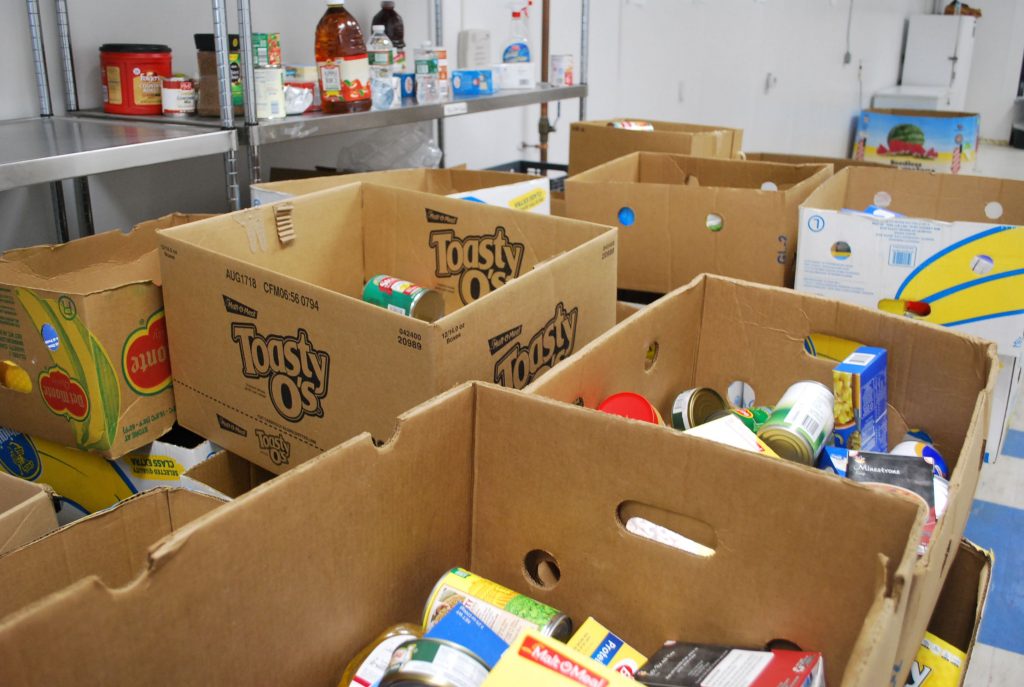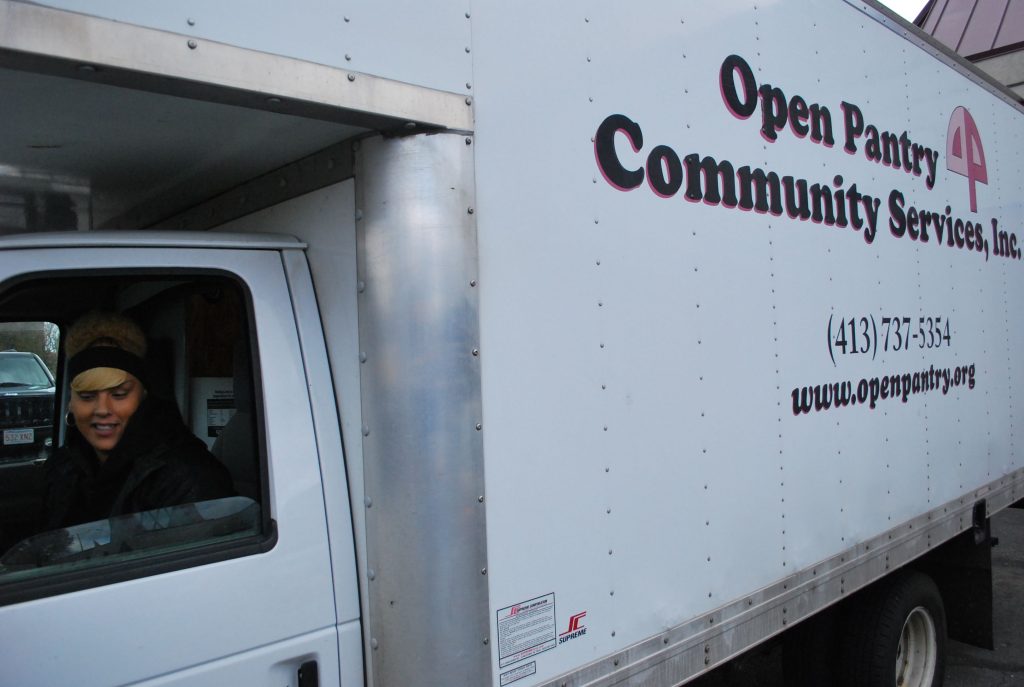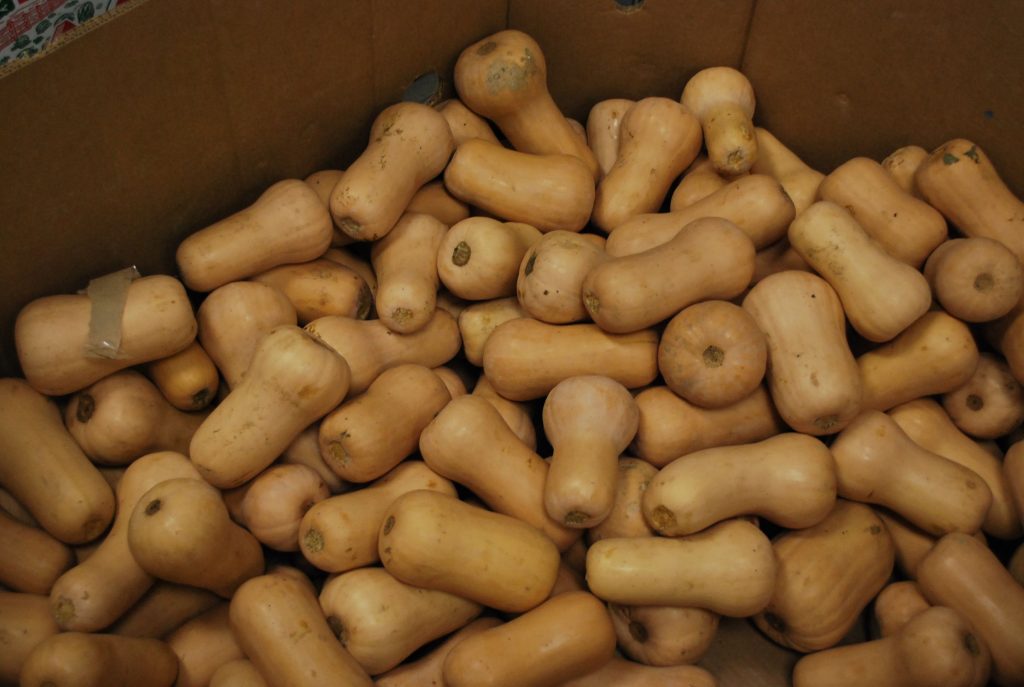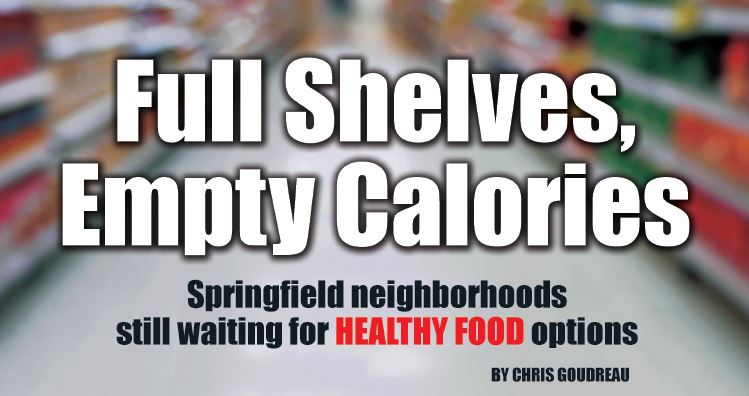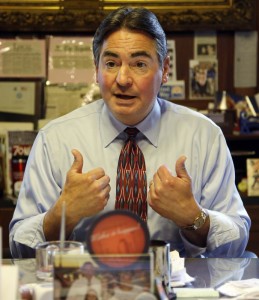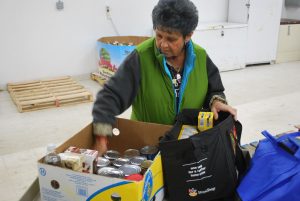It’s been more than two years, since former Valley Advocate staff writer Amanda Drane wrote an article about residents in the Mason Square neighborhood of Springfield who rallied together, collecting 1,300 grocery receipts totaling more than $50,000, to entice businesses to build a grocery store in the community. But that hasn’t happened yet.
Organizers with Gardening the Community and the Food Policy Council in the city of Springfield don’t think city officials have done enough when it comes to providing residents with opportunities to purchase fresh fruits and vegetables in their local neighborhoods. And they are doing their best to step up and fill in the gaps, while at the same time hoping their city will come through for them and attract sorely-needed food hubs.
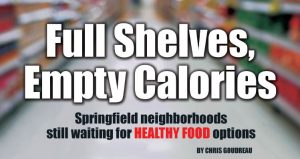 Ibrahim Ali, co-director for youth and programs with Springfield-based Gardening the Community, a nonprofit organization that educates youth about agriculture, said he considers many areas in Springfield to be “food swamps.”
Ibrahim Ali, co-director for youth and programs with Springfield-based Gardening the Community, a nonprofit organization that educates youth about agriculture, said he considers many areas in Springfield to be “food swamps.”
Ali explained that the more commonly used term, “food desert,” doesn’t aptly describe the situation for people who don’t have a quality grocery store in their local neighborhood or access to transportation to bring groceries home.
There’s plenty of fast food restaurants and convenience stores, but few if any businesses that sell fresh and nutrient rich produce. In addition, food swamps are mired in high processed and low nutrient foods that often times contribute to high rates of obesity.
He said despite strong local agriculture roots in nearby communities such as Agawam, Hadley, and Wilbraham, most of that produce is sent east to Worcester and Boston.
More than 223,000 people in Western Massachusetts struggle with food insecurity with 64 percent of people residing in Hampden County, according to data from the Food Bank of Western Massachusetts.
“A lot of opportunity is being missed because there are misconceptions about who lives here and how they spend their money,” he said. “There shouldn’t be a push; there shouldn’t be extra work just to bring fresh food out here. It should be a no brainer.”
Cheap, available, and unhealthy
Liz Wills-O’Gilvie grew up in Springfield and has worked on advocacy for low-income neighborhoods and affordable housing in the past while living in Chicago.
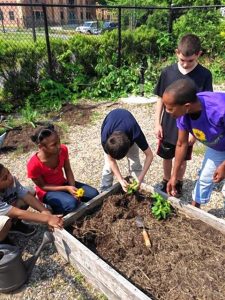
Liz Wills-O’Gilvie, right, works with students from Rebecca Johnson Elementary School in Springfieldin the school’s garden. Courtesy photo
She became interested in food advocacy — something that now takes up a significant portion of her life as a volunteer elementary school gardening educator, chair of the Springfield Food Policy Council Steering Committee, and board chair of Gardening the Community — when her son was born in 2009.
“Now we were a one-income family and I was at home with our baby and there literally was nowhere for me to buy anything that I would have wanted to feed him, other than formula that I bought at the drug store,” she said.
Many neighborhoods, like her neighborhood of Mason Square, are still waiting for a supermarket, but even the ones that do have markets don’t necessarily have better access to healthy foods, she said.
On Friday morning after Thanksgiving, Wills-O’Gilvie led a reporter through Medina’s Supermarket in Springfield’s Memorial Square neighborhood. Outside, there were several Puerto Rican flags in this largely Latino neighborhood. Inside, a few customers pushed carts through the aisles.
Wills-O’Gilvie pointed out that the first thing a customer sees when walking into the market are processed foods, candy, and soda. Walking up and down the rows of foods, she picked up items and indicated the prices. An approximately ¾-gallon jug of orange juice costs $7.29 while half-gallon cartons of Minute Maid fruit punch, some of which has less than 5 percent real juice, were three for five dollars.
A box of Corn Flakes, one of the few boxes of non-sugary cereals available, was listed at $4.79 while similar-sized boxes of sugary cereals were priced at $1.39.
All throughout the store, Wills-O’Gilvie pointed out the lack of healthy options, and the price differences for the few healthy options there were. At the ends of each aisle, she pointed to starchy and sugary snacks shoppers couldn’t help but see as they navigated through the store.
Wills-O’Gilvie had observed the issues a few weeks before when she went into the store to buy a quick snack for an aging relative at the hospital.
“It hit me in the gut when I walked into that store,” she said. “That’s what people have to choose from.”
Jose Medina, the store manager, said Medina’s buys and prices its foods based on a slim profit margin. He said the store layout and organization has not changed much since the store opened in 1992.
“Orange juice costs more to produce, and a lot of times Minute Maid is on promotion,” he said, regarding the drinks’ price disparity. Tropicana rarely has price promotions in the same way, he said.
Medina said his customers mostly buy staples: rice, beans, meats, vegetables, milk, and pasta. He doesn’t put a lot of thought into laying out healthier options, but instead focuses on filling demand, he said. He sells a lot of sugary soda and chips, but he also sells a lot of bananas, yams, and root-based vegetables, he said.
Medina also said the way foods are prepared contributes to health outcomes.
“If you buy bananas and deep fry them, that’s not much of a banana anymore,” he said.
Wills-O’Gilvie doesn’t blame Medina’s Supermarket for the problem. For her, the issue is structural rather than based on any one business. Medina’s doesn’t have the buying power of large supermarket chains, and aren’t able to leverage that into lower prices. Meanwhile, unhealthy foods are available and cheap, and so that is what impoverished people have the incentive to buy, she said.
“If now you’ve got a generation of folks who didn’t grow up eating salad, who didn’t grow up watching their mother steam green beans, it’s not going to be the first thing they reach for,” she said of healthier foods. “Especially when it costs more.”
She is focusing some of her efforts on education of young people.
“Black people die proportionally earlier,” she said with emotion in her voice. “Because if you grow up eating french fries from the time you can chew, you can imagine what your heart looks like by the time you’re 12.”
Attracting a supermarket
Meanwhile, Mayor Domenic Sarno said the city still faces challenges when it comes this issue, but is hopeful that a supermarket would be constructed in the downtown Mason Square area sometime in the next few years.
Sarno said in the meantime there’s been mobile fresh markets in the city, farmers markets, and community gardens that residents can utilize to make they’re eating fresh produce.
“It makes perfect sense to invest in these types of programs and obviously we’ve done some public and private partnerships, but there could be monetary investments from the feds and the states,” he said. “A lot of the times we’re under a lot of unfunded mandates.”
When asked if the city has reached out to Big Y, Stop & Shop, or other grocery chains about developing a grocery store in Mason Square, Sarno replied, “We have and it’s got to be attractive to their bottom line and their market area, too. So, we continue to do that. I think we’re moving in the right direction.”
But Ali said he isn’t holding his breath.
“Telling people they have to wait a few more years is mostly politics,” he said. “Obviously, he wouldn’t want to make a promise that he couldn’t keep.”
Ali said he thinks every neighborhood across the state deserves the opportunity to buy fresh local food, especially where transportation options for bringing groceries home are limited.
“A grocery store in [the Mason Square] neighborhood is long overdue,” he said.
Wills-O’Gilvie said it is important for food advocates in the neighborhood to be a part of the conversation of what gets built. She hopes there will be a working group that will reach out to grocery stores that are working with low-income communities and see if they are willing to expand their work to Springfield.
“There’s this idea that folks in the neighborhood don’t have a lot of value at the development table, and that is really offensive and not true,” she said.
‘That’s how I survive’
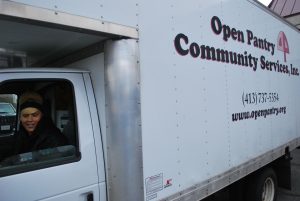
Yolanda Santa works as a truck driver for the Emergency Food Pantry and relies on her once a month supply of food from the pantry. Chris Goudreau photo
Yolanda Santa, a 40-year-old longtime resident of Springfield who lives in an apartment building on Plainfield Street, is a truck driver for the Emergency Food Pantry on Main Street. Once a month, Santa picks ups most of her food from the pantry, she said while volunteers gave away Thanksgiving turkeys to local area residents stopping by the pantry.
“There were times that I was without a job and struggling and all they gave me were food stamps,” she said. “Now that I’ve got this job they took my food stamps away from me …. I work here and try to maintain myself to live in this world because it’s hard.”
Santa said she relies on food from the pantry because most of the money she makes goes toward paying her bills.
“That’s how I survive,” she said.
She thinks the people in her community have been left behind when it comes to access to fresh produce at affordable rates.
“I think they should focus on the ones that are really in need, instead of the casino,” Santa said.
Beverly K-Moses, a resident of Parker Street who stopped by the pantry to pick up her month’s supply of food, said she has access to fresh produce because there’s a grocery store, but thinks it is a serious issue in the city.
“I think there’s a lot of food waste in Springfield,” she said. “There’s a lot of places; restaurants especially, that don’t donate. There’s a lot of waste in Springfield that could benefit people.”
“Unless you’ve gone hungry, you don’t know what it feels like. You will settle for whatever you have to eat, but sometimes it’s not filling enough. I care for an elderly mother, so I’m more apt to give up my food,” K-Moses said.
Why is it still a challenge to buy healthy food in many poor urban neighborhoods? Wills-O’Gilvie thinks the food system in the United States is part of bigger issues relating to economic disparity.
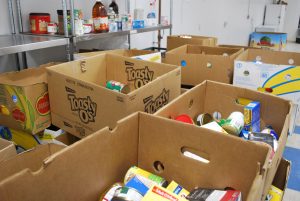
Boxes of donated goods are seen here at the Emergency Food Pantry on Main Street in Springfield. Chris Goudreau photo
“The way that food is, in urban centers in particular, and even in rural communities, didn’t just happen,” she said. “This was a result of policies and practices and therefore it resulted in a system that is not equitable and accessible.”
Springfield and Holyoke have among the highest rates in the state for preventable diseases, including obesity, high blood pressure, and heart disease, she said. Access to fresh produce at affordable rates would help improve health conditions for city residents, she said.
According to a 2014 report called “Springfield Health Equity” created by Springfield-based nonprofit Partners for a Healthier Community, obesity among children and adults in Springfield is greater than the state average.
“An estimated 67 percent of Springfield adults are overweight or obese, compared to 59 percent in the state overall,” the study reads, citing a Massachusetts Department of Public Health report from 2011, which found that 41.8 percent of Springfield children screened during the 2010-2011 school year were overweight or obese, which is almost a third higher than the state average of 32.3 percent.
People of color account for 66 percent of Springfield’s population — an estimated 43 percent of Springfield’s population is Latino; 19 percent is Black, and 2 percent Asian, according to U.S. Census Bureau data.
However, most Springfield households struggle economically. An estimated median household income in Springfield for 2012 was $31,356 compared with the state median of $65,339.
“A number of factors contribute to health inequalities experienced by low-income individuals, including inadequate resources for basic needs that may affect health (e.g. housing, food, transportation, health care), increased likelihood of living in neighborhoods with little access to fresh fruits and vegetables, few opportunities for physical activity, and chronic stress of inadequate resources to support basic needs,” the Springfield Health Equity study reads.
When you look at neighboring communities in Hampden County such as Wilbraham, Longmeadow, and East Longmeadow, which are predominantly white at a rate of 90 percent or more and have the highest median family incomes in the region, the disparity is most notable.
Ali believes that racism and financial inequity have a hand in creating areas without healthy food alternatives across the country.
“I think there is definitely a lack of equity that is reflective, not only in the food system, but in our education system; definitely in the economics of our city and state and federally. All of those things have a way of leaching into all the other avenues. Racism, I think, plays an important and unfortunate role in terms of getting us to where we are right now,” he said. “You can’t just write that off as the natural course of economics.”
Ali said he believes poverty and hunger impact lives in ways that are far reaching.
“You’d be surprised how many people I’ve come across who’ve engaged in all sorts of activities that are not legal based on the fact that when they grew up they were so poor they didn’t have enough to eat,” he said. “That stays in your subconscious. That doesn’t just go away because you’re older … People remember what it’s like to be poor. It can be painful and have tragic endings.”
Food in the schools
Activists say there have been some improvements to food access in Springfield, most notably in Springfield Public Schools, which has been working alongside the Springfield Food Policy Council to provide more nutritious meals for the approximately 26,000 students across all 60 schools in the city.
All students receive breakfast and lunch at no cost and about 12 to 13 percent of the produce students eat is fresh and local, said Timothy Gray, food service administrator for Springfield Public Schools.
Wills-O’Gilvie said the Food Policy Council’s goal is to have the district reach 20 percent in the near future.
“I feel really great that we’re there, but it’s not good enough obviously,” she said. “It makes no sense that we have all these farms up the hill and that we buy USDA apples that come from God knows where,” she said.
The district buys greens and fresh produce from five local area farms, one of which is E. Checci Farms in Feeding Hills, Gray said. Springfield Public Schools has also hired a consultant to study ways in which the district could increase its procurement of fresh produce to meet that 20 percent goal.
The biggest investment the city has made in regards to improving student health and nutrition is the creation of the estimated $22 million Culinary Nutrition Center on Cadwell Drive in Springfield, which is set to break ground in December. The 62,000-square-foot facility with a catering center, produce cutting and processing room, and bakery is expected to open sometime in January 2019.
“The center is being built to improve the quality of the meals that we serve to our students on a daily basis,” Gray said. “Everything will be done from scratch. The center will eliminate or decrease the amount of processed foods that we’re currently purchasing for our students.”
Twenty-five schools in the district also have school gardens, in which students learn how to grow the vegetables they eat.
“They’re able to cultivate the food; harvest the food; see how it’s processed and prepared, and then consume it as part of the lunch program,” Gray said.
Sarno said he believes lack of affordable fresh produce plays a role in families purchasing less expensive snack foods over healthier options, but thinks education on nutrition is an important factor.
“You have to make choices if you’re a parent or a guardian, saying, ‘Okay, this is what you’re going to have’ and maybe every once in a while you give them a little treat,” he said. “You have to guide yourself and your family.”
One of the ways Gardening the Community is helping Springfield residents eat healthier is by selling fresh produce at rates that are cheaper than grocery stores through its farm share, and its planned farm stand on Walnut Street, selling seasonal vegetables such as peppers, tomatoes, kale, collard greens, and herbs year round in urban gardens and greenhouses.
“Our produce that we grow specifically goes to fill the needs of those markets,” Ali said. “We sell the food at a reasonable price regardless of the quality of the food.”
Ali said when he first started working at Gardening the Community, he didn’t have much of a green thumb, but he’s developed a passion for growing food that he shares with Springfield youth, some of whom have never dug a hole before.
“At the very least, they start to question where their food comes from … Without a doubt, many of the youth get a sense of pride being able to grow the food and then harvest the food and bring it home,” he said.
As for what is coming in the future, Wills-O’Gilvie would like to see city nonprofit partner Develop Springfield create a working committee focused on the development of a Mason Square supermarket in the coming months, and she wants a seat on that committee.
“It takes a long time to build a supermarket,” she said, adding that it is important for an active group of people to keep pushing it along.
And she is staying hopeful, avoiding the word “if” when talking about the supermarket. It is always “when.”
Dave Eisenstadter contributed to this story.
Chris Goudreau can be reached at cgoudreau@valleyadvocate.com.

